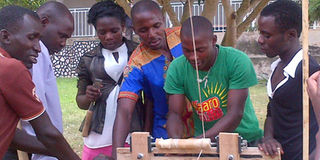How to do carpentry without using electricity

Youth practice using the pole lathe technology. PHOTO BY MICHAEL J. SSALI
What you need to know:
Carpentry relies on both manual skills and electricity in its operations. However, an innovation in Lyantonde District proves that electricity is not necessary in woodwork
Access to electricity remains a big challenge in rural Uganda. As the country invests in setting up more vocational schools and skilling youth to reduce unemployment, the absence of electricity in the rural areas is bound to be a setback.
The existing alternative sources of energy such as generators burn fuel and make noise, which pollutes the environment.
However, this could change with a new innovation. A new effort to enable carpenters do their work without the use of electricity has been launched in Lyantonde District. Six youth, two of them girls, have been introduced to the use of the pole lathe, a device made out of wood, driven by a peddle operated by the carpenter like a manual sewing machine, to make desired designs on timber for furniture. Most carpenters in remote areas normally make long and tedious trips to other towns to have designs made on timber which increases overhead costs.
Roy Godber, a Briton living in Canada, spent about two weeks at Salama Shield Community Centre in Lyantonde Town teaching youth how to make and use pole lathe. He says this innovation has been used in England for centuries and does not require electricity.
Godber describes the pole lathe technology as very appropriate and eco-friendly, capable of producing quality work with no need for fossil fuels, electricity, or high levels of energy input.
At the time when we are faced with climate change challenges the introduction of the pole lathe technology, which only uses fairly light human energy is the most suitable to mitigate global warming.
Godber, with the assistance of the students, made the Pole Lathe with simple tools purchased in Uganda at less than Shs2m.
How it works

The device is mainly pieces of wood fixed together with bolts and nuts. A tree with strong long branches is selected and one of its branches is trimmed at the top without cutting it off the tree.
A cord is tied to the top of that trimmed branch or pole and then wrapped around the wood on the lathe with the other end being tied to the end of the treadle.
When the operator presses the treadle with his foot the wood rotates and he begins producing the desired shape. Once he takes the pressure off the treadle the branch or pole will pull the cord to the starting position.
So the rotation on a pole lathe is reciprocal and the cutting is only done when the treadle is being pressed. “The youth will be free to make more pole lathes and train operators themselves using the same equipment when I am gone,” Godber says, “The more they practice using the pole lathe to make furniture the better they become.”
Impact
Dr Dennis Willms, who heads the Salama Shield Foundation, an Anti-Aids Research Project, says, “Giving such entrepreneurial skills to youth is one of our major goals. When they are empowered to become gainfully self-employed they will be less likely engage in sexually risky behaviour and they will be in a better position to become socially and economically self-reliant.”
For years, the project has been active in Lyantonde District providing health education and loans to women and the youth as well as giving them training in money generating activities so that they become less reliant on prostitution, which promotes the spread of HIV/Aids.
One of the youth that have been undergoing training in Pole Lathe technology, Saphan Twesigye, 24, had prior training in carpentry. “As a young carpenter,” he said, “I had had an issue with how to make designs on the furniture far from Lyantonde where there is electricity. I am sure that when I master the use of this device I will be in position to work in my home village.”
He believes that with this technology it will be possible to conserve energy.
Lillian Nanono, a student at Nsamizi Institute of Social Development, is grateful that she is one of the pioneer youth using the locally made machine which does not use electricity. “My work will be to promote development in rural communities where electricity is often not available and I intend to encourage the youth, particularly carpenters to use the pole lathe instead of making long journeys to towns to get their work done,” she says.
Lyantonde District community officer Sowedi Kyeyune, commended the effort to train the youth in the use of the pole lathe.
He said what is left is to encourage many youth to get the training so that they can carry their carpentry skills to the rural villages.
About the lathe
Invention. The pole lathe technology’s origins date back to the Saxon period in Europe but this is speculation. The first clear evidence of its use comes from two sources in the 13th Century.
Relevance. Today many of the items which were traditionally turned from wood are no longer required. However, the skills to produce them from wood remain strong and will continue for as long as there are those discerning people who appreciate the many practical and aesthetic properties of a turned wooden item.




